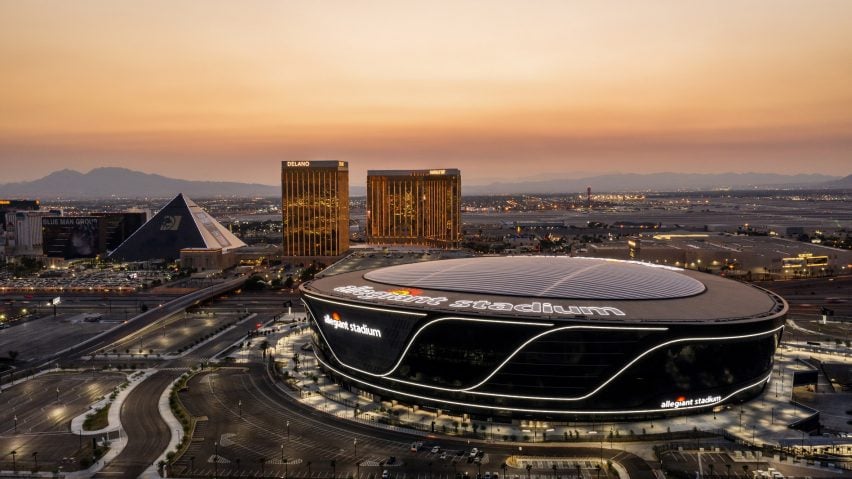This year's NFL Super Bowl will be hosted at the Las Vegas Raiders' Allegiant Stadium in Nevada, which was designed by Manica Architecture to recall the sleekness and power of sportscars.
Opened in 2020, the 62,000-seat stadium by Kansas City-based Manica Architecture is home to NFL team the Raiders, which moved from Oakland when the stadium was completed.
The stadium was initially planned for California as Raiders' owner Mark Davis wanted the team to move to Los Angeles, but then lost out to other teams.
Manica Architecture's initial design had to be adapted to meet the conditions of Las Vegas, with its high-desert climate.
"It was a redesign of the project," Manica Architecture founding principal David Manica told Dezeen.
"It became an indoor building, it became a Raiders-only building. We put a roof over it and we installed a retractable field that slid out – so a lot changed. It became bespoke for the Raiders."
The shift in focus allowed for the design to zero in on the aesthetics of the Raiders and the contemporary architecture in Las Vegas.
Manica said that much of the design was driven by conversations his studio had with Davis and his organisation.
"[Davis] wanted it to be sleek, wanted it to be modern" said Manica. "He wanted it to look fast and angry and intimidating."
The stadium's form is cylindrical, with large swaths of black metal and glass covering its facade. It leans slightly in profile and has sloping bands of LED lights that create S-shaped lines across it.
According to Manica, the tilt and sleek black exterior were designed to mirror the silver and black of the Raiders' colours.
"Black sports cars inspired the design," he said.
"We looked at the way Maserati lines are to give the lines of the building aerodynamic movements – a form gives it motion."
Beyond the formal considerations, the harsh environment of Las Vegas impacted the design, with some questioning the effectiveness of a black glass facade in the desert.
"The truth is that black glass was really helpful when it came to protecting the building from the sunlight," said Manica.
"We were also very careful in the amount of tint that we put on the roof. So in a lot of ways, it was purpose-built for the climate in Vegas."
Many of the interior spaces in the building match the sleek, black-dominated look of the facade and even the stadium seating and detailing are predominately black.
The stadium also features a massive sculpture in the shape of a torch, that, according to Manica is the largest 3D-printed object in the world.
It has a lighting element on the top so it can be "lit" before the games to honour long-time coach and owner of the Raiders, Al Davis.
Following the strict water-management requirements in Las Vegas, a rainwater collection system was integrated into the exterior of the structure.
Captured water is reused for the irrigation of the RIOS-designed landscaping, which is planted with indigenous greenery.
Manica has been working on stadium design for the past 30 years, first with HOK Sport (now Populous) and then under his eponymous studio.
He said that technological, material and construction advancements have allowed large-scale stadium projects to "to soar in a way that they just didn't do 30 years ago."
He also noted that it is an exciting time to work as an architect in Las Vegas due to flexible approvals and other large-scale projects, such as the Sphere, the world's spherical structure with a facade made up of LED screens.
"There's a sizzle to what happens in Vegas and the architecture is a big part of that," he said.
Super Bowl 58 will be played at Allegiant Stadium on 11 February 2024 by the Kansas City Chiefs and San Francisco 49ers.
Last year, architect Peter Eisenman told Dezeen that it's "important to have architecture to part of the NFL. Previously we rounded up the key Super Bowl stadiums.
The photography is by Jason O'Rear.

